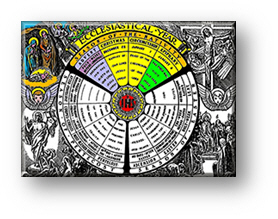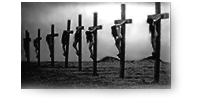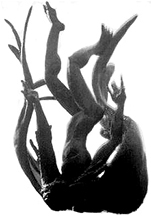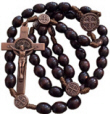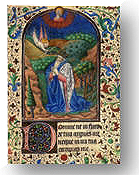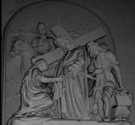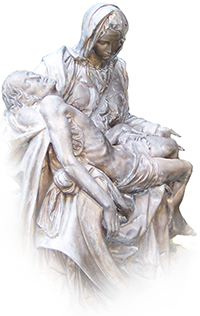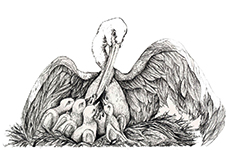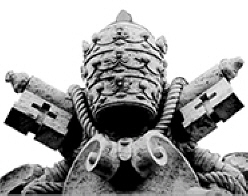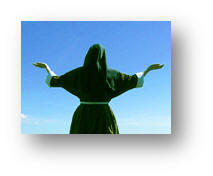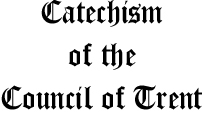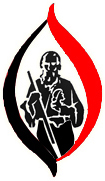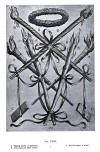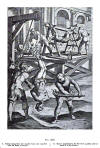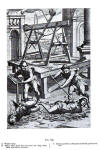|

The Tortures and Torments
of the Christian Martyrs
from
De SS. Martyrum
Cruciatibus
(a Modern Edition)
Chapter VI
Of Red-Hot
Plates, and Torches, and Blazing Brands
While
the Heathen subjected Christians
of either sex to be racked on the horse and mangled with scourges, iron
claws, and the like (as we described in the preceding chapter), and
to be stretched in the stocks to the fourth and fifth hole, still
their savagery and rage remained unabated. In addition to these tortures,
they would often have quicklime, molten lead, or boiling oil poured
over their fresh wounds; at other times they would order them to be
torn open with shards of pottery or violently rubbed and scrubbed with
hair cloths, or lastly, to be horribly burned with red-hot plates, torches,
and blazing brands.
Of
Red-Hot, or Fiery Plates
Fiery Plates are spoke
of by Plautus in his Asinaria in these words:
Stimulos, laminas,
cruceque
(“Goads, plates, and crosses”);
By Cicero,in his Contra
Verres:
“What, then, when
the red-hot plates and other tortures were brought on the scene?
”
By Horace, in his Epistles:
Scilicet ut ventres
lamina candente nepotum
Diceret urendos correctus.
(“So far reformed as to direct his grandsons' bellies to be scorched
with the white-hot plate!”)
Also by St. Cyprian, in
his Praise of Martyrdom:
“For the Martyr’s
body is stretched on the rack and hissing to the red-hot plates.”
By Prudentius in the
Hymn on the Martyrdom of St. Vincent:
Stridensque flammis
lamina ...
(“And the plate hissing with fiery flames ...”)
And again in that of St.
Romanus:
Nec inusta laminis
ardet cutis
(“And the flesh burns scorched by the plates”);
And lastly, Victor in
the Vandal Persecution:
“For then did Papinian,
the venerable Bishop and Father of our City, have all his body burned
with white-hot plates of iron.”
The Acts of the Blessed
Martyrs are filled with instances of this kind of torture, and Eusebius
mentions it repeatedly, particularly in his Ecclesiastical History.
In fact, such burning, when confined to the sides, was counted among
common and public punishments.
As a means of torture, a plate in this sense was (as many of the above
quoted authorities and numerous Histories of the Holy Martyrs
appear to imply) a piece of any metal, longer than it was broad, and
thicker than a layer or leaf. In fact, a layer or leaf differs from
a plate in that the former is thinner and will bend spontaneously, and
crackles, whereas a plate is thicker and makes no crackling sound. Armor
is made from this type of plate, and when heated red-hot was often used
in antiquity for purposes of torture. Such a piece of iron heated in
the fire was applied to the bare flesh of the Blessed Martyrs or of
criminals, and held there until it had miserably burned the victim.
It was with this instrument of martyrdom that those most glorious
soldiers of Christ, St. Laurence, St. Bassus Bishop, St. Vincent, and
many others were tortured.
Furthermore the
Theatre of Cruelties shows how, in many cases, the Heretics of
our own day have used the same method, and how Catholics even at the
present time (1591) have been burned with fiery plates by the Huguenots
and Calvinists.
Of
the Torches with which the Blessed Martyrs were Burned
Torches are mentioned
in many of the Histories of the Saints, especially those of St.
Saba, an officer of soldiers; of Saints Eulalia of Emerita and Barbara,
virgins and martyrs; and of St. Clement, Bishop of Ancyra.
These torches were of two sorts — some were made of the inner and denser
parts of trees which produce resin, such as the pine, pitch-pine, larch,
or fir. These types of torches are often spoke of by ancient writers
such as Varro, who writes:
“Rome is alive with
women; and what rites were done at night-time, even now a pine torch
indicates;” and again, “A torch is there, wrapped about with flame.”
So also Virgil, in his
First Georgic:
Ferro faces inspicat
acutas
(“He sharpens pointed torches with the knife ”), where by torches
the Commentators understand brands of pine wood.
And we find in his
Seventh Aeneid:
Et castis reolent
altaria tedis
(“And the altars are fragrant with consecrated pine torches”).
So too, Cicero:
“Rushing to and fro
in terror of the Furies' blazing torches;” and in another speech,
“Just as on the stage, Conscript Fathers, you see men, driven into
crime by constraint of the gods, shudder in terror before the blazing
torches of the Furies.”
And lastly, by Suetonius
in his Life of Nero:
“Often, the Emperor
confessed, was he terrified by his mother's phantom, the whips of
the Furies and their blazing torches.”
Torches of the second
kind were made of twisted coils of rope smeared with wax or pitch. These
are mentioned by Virgil, in his First Aeneid:
Et noctem flammis
funalia vincunt
(“And torches disperse the darkness with their flames”)
By Cicero, in De Senectute:
“His delight was in
the torch of wax;” and again in the De Officiis, “Statues
stood in every street, at which frankincense and torches of wax
...”
And by Valerius Maximus,
in speaking of Caius Duilius,
“Going to feast by
the light of a torch of wax, with a flute-player preceding him.”
With this distinction
explained, we may add that torches of both these sorts — to wit,
pine torches and torches of waxed or pitched rope — were used by the
Heathen for scorching Christians to the point of death. The use of pine
torches is attested by the Acts of St. Barbara, virgin and martyr,
cited above (for while some have maintained that the Saint was burned
with torches, others have recorded more particularly that it was with
pine torches that she was tortured.
In fact both kinds of torches were often used in those days, as the
authors we have quoted seem to indicate. But of the two, the pitch-pine
is more abundant in resin than the other trees which produce resin as
well, and produce a more pleasant flame (as Pliny says) and supply light
for sacred functions. Torches, therefore, made of pitch-pine were more
in use in antiquity than any others of a similar sort.
This form of torture is also — as we find in the Theatre of Cruelties
— employed by the heretics of our own day for afflicting Catholics,
and particularly by the Huguenots in their hatred of our holy religion,
as we read in that work.
Of
Blazing Brands, or Flambeaux
Mention was earlier made
of burning brands — which some mistakenly confuse with
torches — in sundry Acts of the Blessed Martyrs, as of Saints
Theophilus, Felix and Fortunatus, Pantaleon, Regina virgin and martyr,
Theodore a priest, Alexander a Bishop, Parmenius and his companions,
and countless other holy martyrs.
These brands or flambeaux belong — if representations of them carved
in ancient marble to be seen in Rome are in fact accurate
— to the same general class as torches, but were made in the following
way: first, certain vessels were narrowed from the top or mouth to a
gradually more and more contracted shape, like a pyramid reversed or
turned upside down. These vessels were either of earthenware, as is
shown by some that are, from time to time, dug up in the ruins of Rome,
or else of iron, as Columella states. Afterward, they were enclosed
with little staves of wood squared and tied together, and which like
the vessels themselves were made finer and smaller from the top downward,
and were then filled with fuel which gave off fire and flame. These
staves, if we consider the uses to which these flambeaux were put, we
must conceive of as being some five or six spans long, more or less.
But that the instruments that we have described from ancient examples
were flambeaux and not torches, that is torches of pine-wood,
or of twisted coils of rope, can be proven in many ways. In the first
place it should be noticed in the marble engravings we mentioned before
that the flame begins to burn more fiercely where the staves end, from
which it follows they were not torches of the first kind, but of the
second, to wit, brands or flambeaux; for if they had been ordinary
torches, the wooden staves, which acted as handles, would necessarily
have been consumed by the fire contained in the vessels. Consider, moreover,
that we never see wax tapers burning all their length in candlesticks,
but only at the end, so that they may the more efficiently burn and
be consumed, and therefore giving better light.
Some may perhaps object, and say there is nothing really to show they
were not ordinary torches of the first sort, inasmuch as the staves
or handles were not burned because they were of iron, and not of wood
at all. But this cannot possibly have been the case, for these brands
or flambeaux were employed by the ancients for scorching criminals when
hoisted on the horse, or suspended aloft, or tied up to pillars or stakes,
and must therefore be conceived as having been light rather than heavy,
so that the executioners might readily wield them in their hands. This
view moreover is confirmed by the example of the iron claws or nippers
mentioned earlier; for these, though of no great weight, were yet attached
to very light handles for the easier torturing of condemned persons.
It is clear from these and other considerations that these brands or
flambeaux were different from the ordinary torches first described;
and Virgil confirms this by these verses in his Ninth Aeneid:
Princeps ardentem
conjecit lampada Turnus,
Et flammam affixit lateri, quae plurima vento
Corripuit tabulas, et postibus haesit adesis.
(“First Turnus hurled a blazing brand and touched the flank
with flame, that fanned to fury by the wind seized on the planks
and cleaved to the doorposts, which it began to gnaw away.”)
Of
the Manner in which the Martyrs were Burned and Scorched with Fiery
Brands
In just the same fashion
were the Blessed Martyrs burned and scorched with these fiery brands
as they were tortured by means of iron claws, currycombs and hooks —
as is testified by many of the Acts of the Martyrs above quoted
and the details we have already provided in Chapter I concerning pillars,
trees and stakes as employed in torturing Christ's servants.
Of
Torments by which the Martyrs were Tortured after being Taken Down from
the Horse
Lastly it must be noted
how these same servants of Christ, after being taken down from the wooden
horse, were then tortured with the different instruments described above,
or else racked and stretched and their legs drawn asunder in the stocks
to the fourth or fifth hole (as related in Chapter III), or rolled naked
over shards of pottery, or even sometimes drenched with boiling oil
or the like. These torments are illustrated in the Acts of the
Blessed Martyrs — in the case of St. Vincent and St. Pelagius, of St.
Felix and St. Fortunatus, and others.
CHAPTER VII
Illustrations
for Chapter VI:
Chapters:
1 -
2 -
3 -
4 -
5 -
6 -
7 -
8 -
9 -
10 -
11 -
12

Totally Faithful to the Sacred
Deposit of Faith entrusted to the Holy See in Rome
“Scio
opera tua ... quia modicum habes virtutem, et servasti verbum
Meum, nec non negasti Nomen Meum”
“I
know your works ... that you have but little power, and
yet you have kept My word, and have not denied My Name.”
(Apocalypse
3.8)
Copyright © 2004
- 2026 Boston Catholic Journal. All rights reserved. Unless
otherwise stated, permission is granted by the Boston Catholic
Journal for the copying and distribution of the articles
and audio files under the following conditions: No
additions, deletions, or changes are to be made to the text
or audio files in any way, and the copies may not be sold
for a profit. In the reproduction, in any format of any
image, graphic, text, or audio file, attribution must be
given to the Boston Catholic Journal.
|
|

